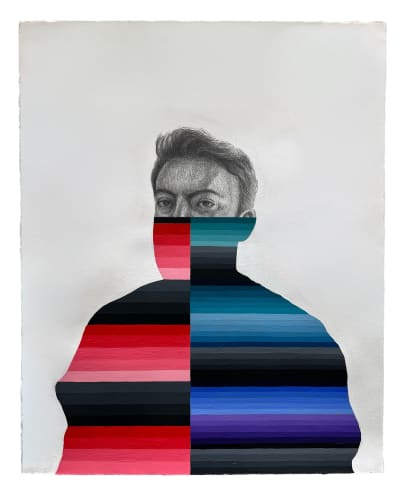
Alejandro Macias is a visual artist whose work examines identity, place, and the socio-political landscape through a Mexican-American lens. Raised along the U.S.-Mexico border in Brownsville, Texas, Macias draws from personal and regional histories to explore themes of assimilation, migration, and cultural hybridity. His practice integrates traditional rendering, abstraction, and multi-media approaches, often using the human figure as a central point of his practice.
Macias’s work has been featured in New American Paintings, Southwest Contemporary, and the nationally traveling exhibition Icons and Symbols of the Borderland: Art from the U.S./Mexico Crossroads. He has participated in major exhibitions across the country, including the 2024 Texas Biennial at Sawyer Yards, the 2024 Border Biennial at the El Paso Museum of Art, and the 2023 Arizona Biennial at the Tucson Museum of Art. His paintings are part of the permanent collections at the Newark Museum of Art, Phoenix Art Museum, El Paso Museum of Art, Tucson Museum of Art, Mexic-Arte Museum, and the Brownsville Museum of Fine Art.
His recent honors include the 2023 Lehmann Emerging Artist Award from the Phoenix Art Museum and the Artist2Artist Art Matters Fellowship. He has held artist residencies at the Vermont Studio Center, MASS MoCA, the Wassaic Project, Château Orquevaux in France, CALA Alliance in Phoenix, and the Elizabeth Murray Artist Residency in New York, among others.
Macias has presented solo exhibitions at the Louise Hopkins Underwood Center for the Arts, Presa House Gallery, Tucson Museum of Art, and LatchKey Gallery in New York.
He currently serves as Associate Professor of Painting and Drawing at the University of Arizona in Tucson.
I often work with acrylic, oil, graphite, and found objects, shifting fluidly between representation and disruption. Materiality plays a central role in my process, as dense, tactile surfaces, gestural marks, and layered transparencies become metaphors for memory, erasure, and displacement. Bisected panels and fractured plans function as both visual strategies and conceptual frameworks. My compositional decisions are not merely aesthetic; rather, they serve as intentional strategies for articulating the complexities of border life and asserting presence within contested spaces.
